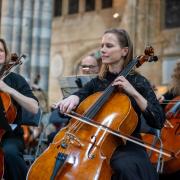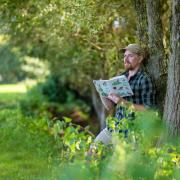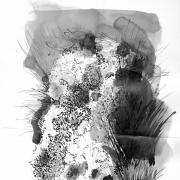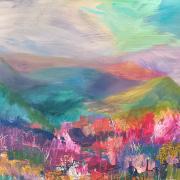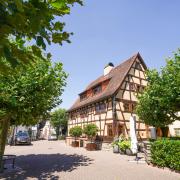Photographer Lee Pengelly urges everyone to get out onto our moors at night and looks upwards with their camera

“Astronomy compels the soul to look upward, and leads us from this world to another,” Plato once wrote. Sadly in this day and age the connection to our environment is being lost; we are all chained to computer screens and the daily rat race. We forget to appreciate what is around us, and indeed above us.
The night sky is an awesome sight and one that 90 per cent of us rarely notice. With urban life sprawling out across our little island, the chance of witnessing the night sky in its full glory is tainted by light pollution from cities and flood lit motorways and streets, diluting the full effect of the heavens above.
Fortunately, living in Devon, you don’t have to venture far to discover the dark side; famous constellations, planets, meteor showers, shooting stars and the Milky Way are all perfectly visible and within easy reach.

Internationally there are 11 Dark Sky Reserves, four of which are in the UK – Snowdonia, Brecon Beacons, the South Downs and our very own Exmoor, which was awarded International Dark Sky Reserve in 2011.
The South West has plenty of star gazing spots, thanks to lower light pollution levels. A quick scan of a light pollution map of the UK confirms that our county has numerous dark sky locations from where to stage your star gazing trips.
These include south facing coastal locations such as Start Point – great for viewing the Milky Way, and of course Dartmoor.

The land locked National Park is not at present listed as a dark sky reserve, despite it having some of the best dark sky areas in the country.
It is possible that Dartmoor may apply for dark sky status in the near future, partnering with local groups who are eager for the National Park to be recognised. Although by all accounts the process of application is a lengthy and time-consuming one.
On the plus side: Dartmoor is very accessible from all sides and a great place to view the night sky. Polaris (the North Star), for example, can be viewed and photographed with little to no light pollution from various points on Dartmoor.

You don’t have to be an astronomer to get out and view the night sky. Armed with some basic knowledge stargazing will open up a whole new world for you.
Stargazing is obviously a nocturnal activity and the best viewing times are after 11pm, and ideally between midnight and 3am.
An arduous hike isn’t necessary - there are plenty of locations on the fringes of the moor where you can view the cosmos in full detail – Nun’s Cross Farm for instance, is ideally situated as is Great Staple Tor and Haytor, all within easy reach without a degree in map reading.

Watch your local weather forecast and wait for a clear night, ideally with no wind. Moon phases are important to understand too, the best viewing time is on a New Moon, where in fact the moon isn’t in the sky.
Take your phone and use its compass feature to determine north. When photographing a spinning star trail the North Star, which will then be at the centre of the image with stars spinning around it.
Most smart phones now have access to a number of star gazing apps, Star Walk (iPhone) and Google Sky (Android) will not only guide you toward the best spot but also educate on the stars and constellations you are seeing. Photopills is another great app for photographers as it shows times and trajectories for the Milky Way in any given location.

Milky Way season is between March and October when the galactic centre is visible in the Northern Hemisphere.
Be sure to take warm clothing - even in high summer temperatures can drop rapidly at night. A head torch or handheld torch with a red light is good to retain your night vision whilst still giving enough light to guide you to your location.
Bug repellant is also a bonus for summer nights; midges are rife on Dartmoor and make for an unpleasant session if unprepared.

If you are going alone be sure to tell someone where you plan to go and what time you plan to return, the weather on Dartmoor and Exmoor is especially unpredictable.
Astrophotography is a time consuming affair, be prepared to spend 3-4 hours in situ photographing star trails, and learn to use your camera in the dark – easier said then done.
Digital cameras are now capable of recording detail that the naked eye can’t see, with time-lapse modes and techniques adding an extra element of fun to a star gazing trip.

The National Trust run star gazing events throughout the year, a great introduction to the basics if you are unsure at first.
Turn off the tablet, put your phone on silent and get out there. “Look up at the stars and not down at your feet,” as Stephen Hawking said.
Astrophotography tips
Equipment: A camera with the ability to manually focus is best, with a shutter speed range of up to 30 seconds and the ability to trigger the shutter remotely. A sturdy tripod or some means of stable support is essential as the camera will be using long exposures.
Focus: Find a focus point and set your focus manually switching off autofocus.
Settings: Set your shutter speed to between 20-30 seconds. Your aperture should be at its widest i.e.; F2.8. ISO speed set to between 1600-3200.
Take the shot: Trigger the camera shutter remotely, check the result and adjust the settings in exposure/focus if needed.
Star trails: A star trail image requires a series of around 3-400 images taken at around 30 second exposures with an interval of around 20 seconds between each shot. Use an intervalometer to trigger this sequence remotely. The images are then merged together in Photoshop or via star trail software to create a spin or streak effect, recorded as the Earth rotates.
Check out Lee Pengelly’s work by clicking here.
_____________________




